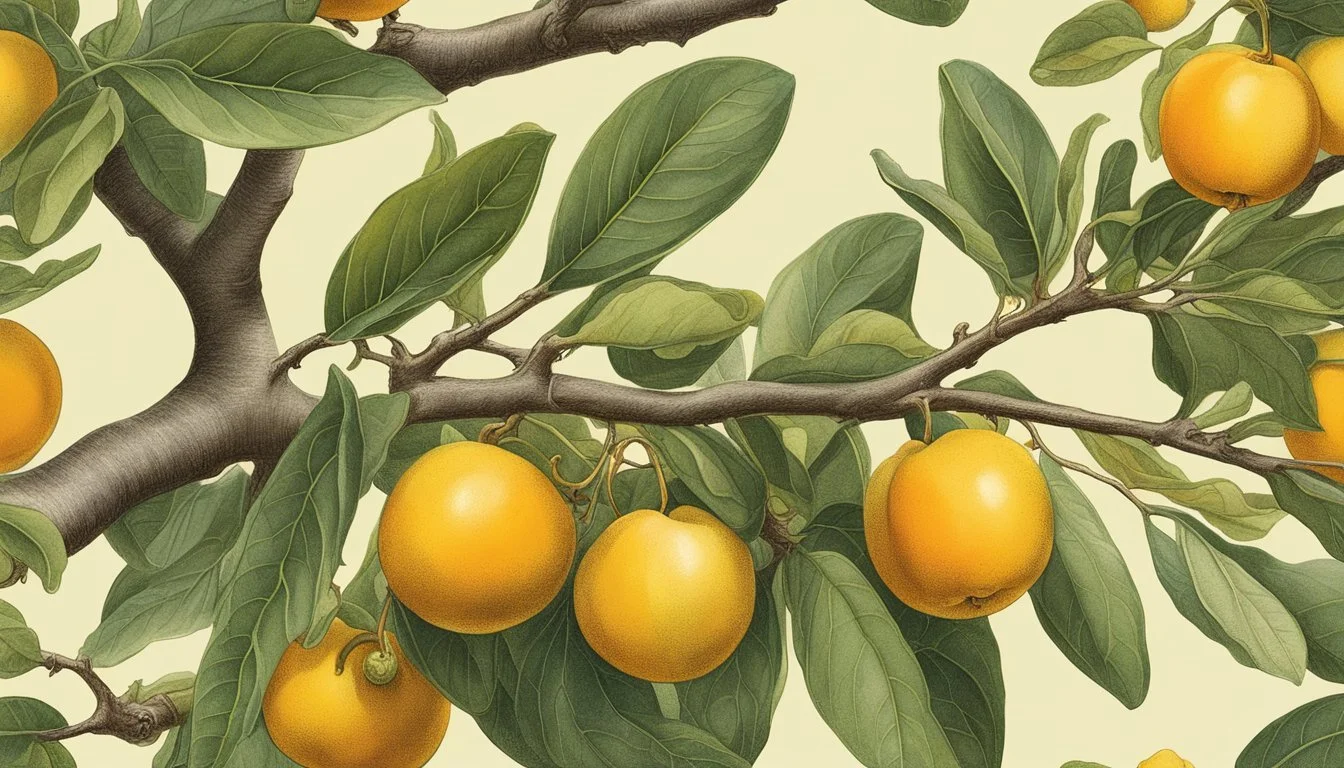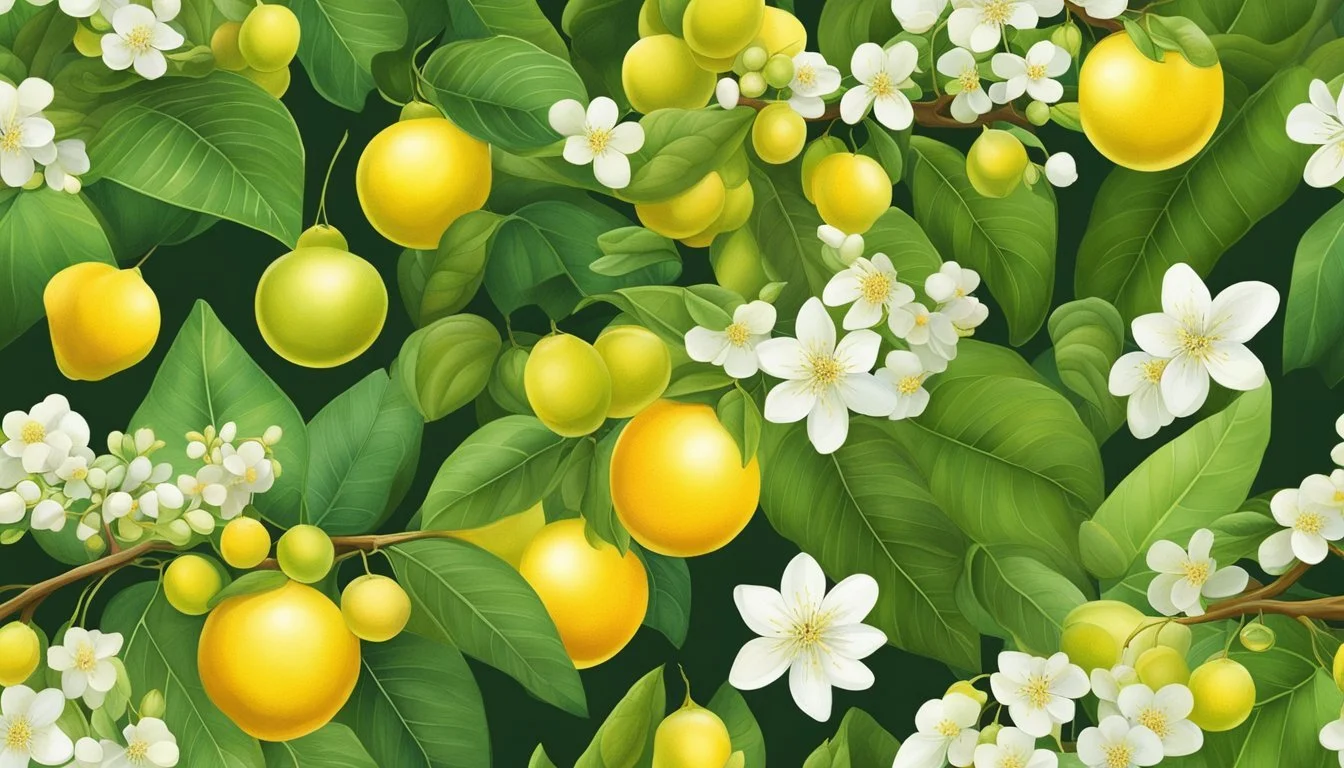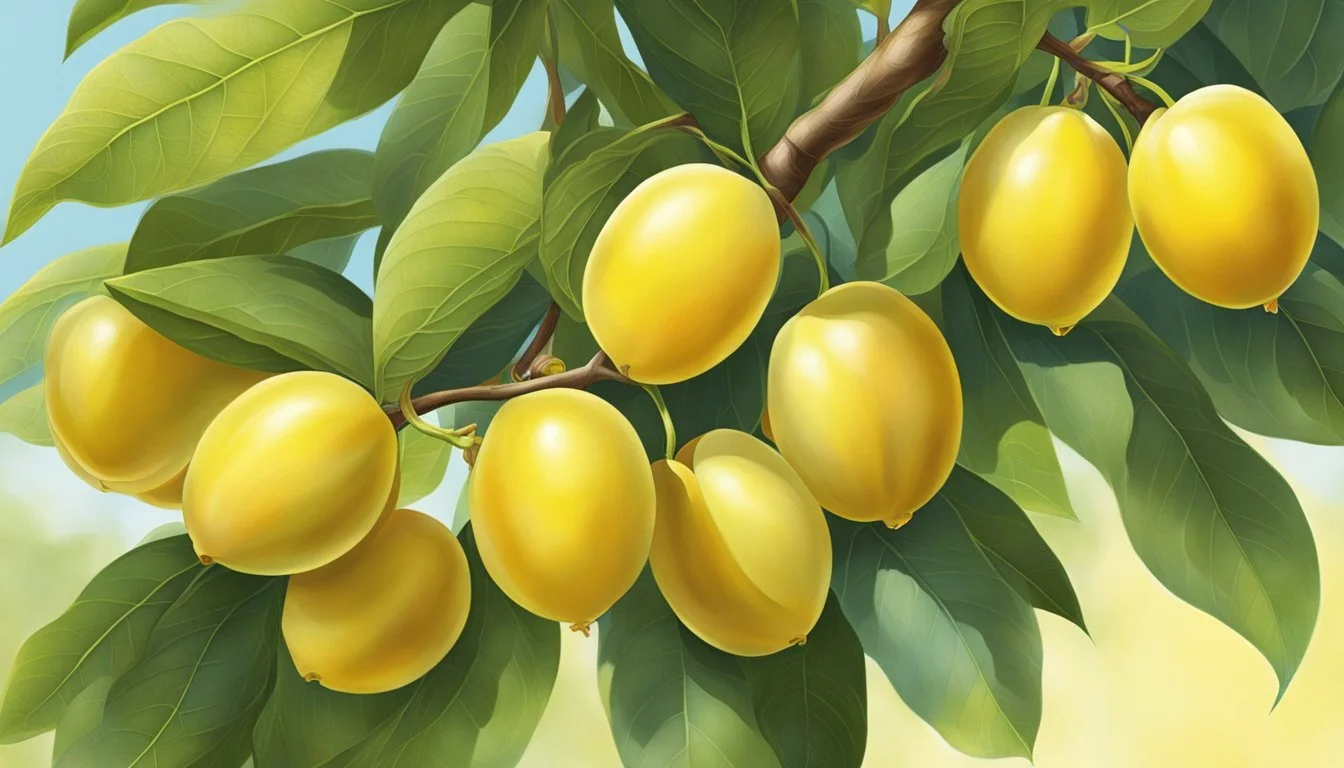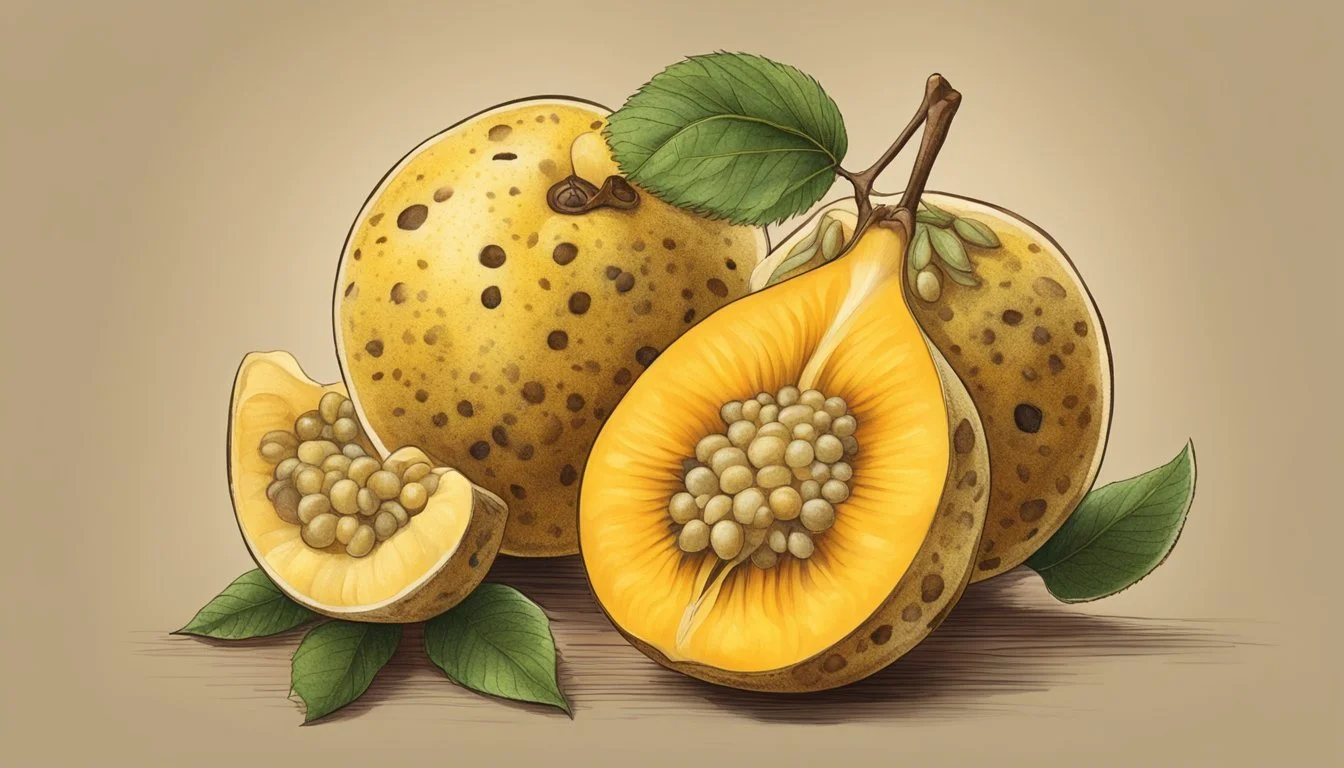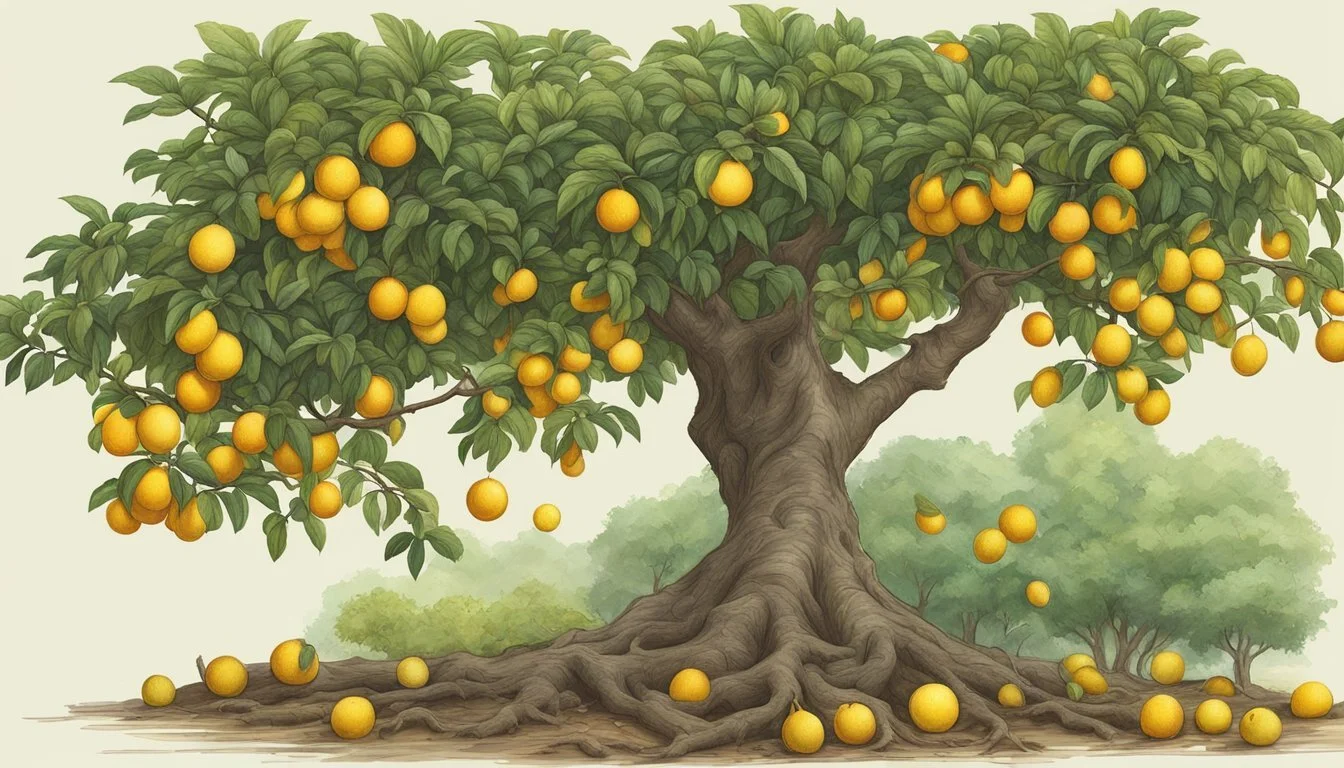How to Tell if an Ambarella is Ripe
Identifying Peak Freshness and Flavor
Determining the ripeness of Ambarella, also known as June Plum or Spondias dulcis, is crucial for enjoying this tropical fruit at its best. Recognizable by its green color that shifts to a more golden hue as it matures, the Ambarella fruit has a unique taste that is often compared to a blend of pineapple and mango with a crispness reminiscent of apples. The texture and flavor of the fruit will vary significantly depending on its ripeness; unripe Ambarella is typically firmer and tangier, whereas the ripe fruit is juicier and mellower.
Ambarella trees are found in tropical and subtropical climates and bearing fruit that hang in clusters. Unlike fruits that may ripen further after being picked, June Plums are best harvested when they've reached full maturity on the tree. To fully enjoy the culinary versatility of Ambarella, which ranges from being a staple in pickles and chutneys to a refreshing snack or smoothie ingredient, it's important to recognize the right stage of ripeness. Not only is it important for taste but also for reaping the nutritional benefits, as ripe Ambarella is known for being rich in vitamins and antioxidants.
Key Takeaways
Ambarella fruits change from green to golden as they mature, indicating ripeness.
The optimal time to harvest June Plum is at full maturity for best flavor and nutritional value.
Ripe Ambarella offers a mellow sweetness, ideal for a wide range of culinary applications.
Cultural Significance of Ambarella
Ambarella, widely known as June Plum, has held cultural importance in tropical regions where it thrives, particularly due to its refreshing taste and versatility in various culinary applications.
Historical Background
Originating from the South Pacific and Southeast Asia, Ambarella has spread to many tropical and sub-tropical regions across the globe where it is cherished both for its fruit and cultural presence. It goes by various names such as golden apple in the Caribbean, tahitian apple in parts of Oceania, and jewish plum or hog plum in other areas, reflecting its integration into diverse cultures over time. With its initial cultivation thought to be in Polynesia, this fruit has become a staple in local cuisines and is often associated with traditional dishes.
Common Names and Varieties
June Plum: Known for ripening around June in the Northern Hemisphere, this name is commonly used in Jamaica.
Golden Apple: In the Caribbean, where vivid color is treasured, it is called the golden apple when it reaches full maturity.
Hog Plum: This name is sometimes used in Southeast Asia and is descriptive of its ubiquity and variety of culinary uses.
Tahitian Apple: A name that pays homage to the fruit's Polynesian roots.
Each name signifies the fruit’s adaptation to local climates and cultural preferences, with various regions developing their distinct varieties based on agricultural practices and environmental factors.
Botanical Characteristics
The Ambarella, also known as June Plum, is a tropical fruit tree, notable for its unusual fruit and distinct leaf pattern. This section will detail the tree's structure, the visual and tactile cues of its fruit, and the morphology of its leaves.
Tree Description
The June Plum tree is a fast-growing tropical species, and can gain height rapidly under suitable conditions. It has a sturdy, short trunk and can grow to a substantial size, displaying a rounded canopy. This sizeable tree can bear clusters of the substantial fruit.
Fruit Description
Ambarella fruit are oval to slightly irregular in shape and measure approximately 2 1/2 to 3 1/2 inches long. The skin is thin yet tough, and the immature fruit is green, turning more yellowish as it ripens. Each June Plum contains a fibrous pit that is edible when cooked. When ripe, these fruits exude a slight fragrant aroma and yield to gentle pressure.
Leaf Characteristics
The leaves of the June Plum tree are pinnate, with an alternating pattern. Each leaf is typically elliptic in shape, boasting a glossy green surface. The mature leaves give the tree a lush, tropical aesthetic. The overall foliage presentation can be used as an indirect indicator of the tree's health and fruit-bearing potential.
Cultivation and Growth
Understanding the cultivation and growth of Ambarella, or June Plum, requires specific attention to climate adaptation, proper planting techniques, and pest management. Mastery of these elements, along with reliable propagation methods, ensures healthy trees and abundant fruit production.
Climate and Geography
Ambarella thrives in a tropical climate and is commonly grown in regions such as the Caribbean, Asia, and parts of the United States like Florida and California. These trees require full sun and perform well in areas that offer high humidity and protection from frost.
Best Regions for Cultivation:
Tropical climates (e.g., Caribbean, Asia)
Sub-tropical regions of the United States (e.g., South Florida, Southern California)
Planting and Care
To encourage healthy growth, June Plum trees should be planted in well-draining soil. Dwarf varieties are available for those with limited space, such as in a home garden setting. Regular pruning is essential to maintain size and promote fruit production. Fertilizer should be applied during the growing season to support growth.
Planting Steps:
Select a sunny location with protection from strong winds.
Dig a hole that is wider than the root ball.
Plant the tree ensuring it's level with the soil surface.
Care Tips:
Apply mulch to retain soil moisture.
Water regularly while avoiding waterlogging.
Prune as necessary to maintain the desired shape.
Pests and Diseases
June Plum trees can be affected by various pests and diseases. Regular inspections are essential to identify and manage problems early on. Effective strategies include cultural, biological, and chemical controls tailored to specific issues.
Common Challenges:
Pests: Fruit flies, borers, and aphids
Diseases: Fungal infections such as anthracnose
Propagation Methods
The methods to propagate Ambarella include hardwood cuttings, grafting, and air-layering. Each technique has its specific practices and success rates, but grafting and air-layering are commonly preferred for achieving clones of parent trees with desirable traits.
Propagation Techniques:
Hardwood Cuttings: Cut and plant during the dormant season.
Grafting: Best performed in the spring using scions from healthy trees.
Air-layering: Suitable for propagation throughout the growing season.
Identifying Ripeness
When assessing the ripeness of an Ambarella, also known as a June Plum, one must observe specific changes in color and texture, check for alterations in size and firmness, and finally evaluate the flavor profile which varies between sour and sweet stages of ripeness.
Color and Texture
A ripe Ambarella fruit transitions from a bright green to a more golden-yellow hue. The once glossy, green surface becomes slightly duller as the fruit matures. The flesh, initially firm and crisp, will soften slightly, indicating that the fruit is approaching full ripeness.
Size and Firmness
Ripe Ambarella fruits are typically larger, as they have completed their growth phase. They measure more than a pound each in some cases. While the fruit will still maintain a degree of firmness when ripe, it should yield gently to pressure. A fruit that is overly hard is likely not yet ripe, maintaining its immature, green state.
Flavor Profile
The flavor of a ripe Ambarella fruit is distinctively sweet with hints of tanginess. The unripe fruit is often more sour and less flavorful. As the fruit reaches full ripeness, there's a noticeable increase in sweetness, providing a balanced taste that is indicative of a ripe June Plum.
Harvest and Post-Harvest
Before consuming or marketing Ambarella fruits, one must understand the nuances of harvest timing and post-harvest handling. These factors are critical for maintaining the fruit's quality and extending its shelf life.
Optimal Harvesting Time
Ambarella, commonly known as June Plum, can be harvested once they attain a size of approximately 2.4 to 3.5 inches in length. They can be picked when they're green or once they've turned a golden yellow. When harvested green, June Plums offer a milder flavor. However, for full sweetness, it is best to wait until they ripen and the skin takes on its ripe yellow hue. This typically happens in the fall, but timing may vary based on the local climate and tree conditions.
Storage Techniques
After harvesting, June plums can be stored in various ways depending on their ripeness and intended use. For ripe fruits that are meant to be eaten fresh, they should be placed in the refrigerator, where they can last up to a few weeks. Unripe, green fruits can be stored at room temperature until they ripen.
For longer preservation, ripe Ambarella can be pickled or steamed to create different condiments and flavoring agents. If one intends to keep the fruit frozen, they should be peeled, deseeded, and cut into pieces. This preparation helps maintain their quality for up to several months inside a freezer.
Here's a list of storage methods based on the fruit's state:
Ripe June Plums:
Refrigerate immediately for up to a few weeks.
Pickle or steam to preserve.
Freeze in pieces after peeling and deseeding for extended use.
Unripe June Plums:
Store at room temperature until they fully ripen.
Shelf Life
The shelf life of June Plums varies greatly based on the storage method used. When stored properly in the refrigerator, ripe June Plums can last up to a few weeks; whereas, at room temperature, they will ripen in a few days' time. In the freezer, prepped June Plums can last for several months. Unripe fruits stored at room temperature will gradually ripen and should then follow the ripe storage procedure to ensure longevity. Not abiding by these methods can lead to premature spoilage and a loss of the fruit's robust flavor.
Culinary Uses
The Ambarella, or June Plum, when ripe, presents a range of culinary possibilities, from traditional recipes ingrained in cultural heritages to modern culinary innovations that showcase its versatility.
Traditional Recipes
In traditional recipes, ripe June Plums are often used to create jams and chutneys that serve as accompaniments to various dishes. The softened fruit easily blends with spices to create rich, savory, and sometimes spicy sauces. Regions that grow Ambarella typically have traditional recipes passed down through generations, where the fruit may be stewed, ensuring that its unique flavor enriches the dish.
Jams: June Plum jams are common, where the fruit's natural pectin aids in setting.
Chutneys: A blend of ripe Ambarella, spices, and vinegar creates a tangy condiment often paired with curries.
Modern Preparations
Chefs and culinary enthusiasts have taken a modern approach by incorporating ripe June Plums into contemporary dishes. Beyond traditional uses, Ambarella can be found in refreshing juices and seasonings for exotic cocktails, or employed to tenderize meat due to its enzymatic properties. The fruit’s versatility extends to sweet and savory realms alike.
Juices: A ripe June Plum is rich in juice, commonly used in tropical beverages.
Tenderize Meat: The enzymes in the fruit can break down proteins, making it an effective natural meat tenderizer.
Ripe Ambarellas are also utilized in soups, adding a burst of fruity brightness, and in pickles, where they lend their crisp texture and tartness to the brine. The fruit holds tough under various preparation methods, making it a valuable addition to any culinary repertoire.
Nutritional Information and Health Benefits
Ambarella, commonly known as June Plum, is a fruit rich in various nutrients that contribute to its numerous health benefits. The fruit is a good source of dietary fiber, which aids in digestion and can help alleviate issues like constipation. A high water content further assists in preventing dehydration and supports regular bowel movements.
June Plum is also notable for its Vitamin C content. This essential vitamin is known for strengthening the immune system and aiding in collagen production, which is vital for skin, bone, and joint health. The presence of antioxidants in the fruit helps combat oxidative stress and may reduce the risk of chronic diseases.
The mineral content in Ambarella includes iron and phosphorus. Iron is critical for oxygen transport in the blood, while phosphorus plays a role in the formation of bones and teeth, as well as the maintenance of kidney, muscle, and nerve function.
Here's a simplified nutritional profile of June Plum per 100 grams:
Nutrient: Fiber
Value: 3.3g
Nutrient: Vitamin C
Value: 23mg
Nutrient: Iron
Value: 0.3mg
Nutrient: Phosphorus
Value: 23mg
These nutrients, combined with its antioxidant properties, imply that consuming June Plum may offer various health benefits. The antioxidants may help mitigate premature aging by protecting the skin from free radical damage. Moreover, the natural antibiotic properties of the fruit support the body's ability to resist harmful bacteria and infections.
In summary, Ambarella offers both nutritional value and potential health-promoting qualities, making it a beneficial addition to a balanced diet.
Ambarella in Home Gardens
Growing Ambarella, or June Plum trees, in the home garden can be a rewarding experience if one selects the right variety and commits to proper maintenance. These tropical fruit trees thrive in specific conditions and require careful attention to detail.
Choosing the Right Variety
When opting for a June Plum tree for the garden, it should be noted that there are dwarf varieties available. These smaller trees are ideal for spaces with limitations, as they don't grow as large as the standard types yet still produce a bountiful harvest. The selection should be based on the climate and available space, with an emphasis on sourcing from reputable nurseries known for healthy, disease-resistant plants.
Standard June Plum Tree: Ideal for large spaces, capable of reaching full size.
Dwarf June Plum Tree: Suitable for smaller gardens or as a potted plant, achieving a reduced size while still fruiting.
Maintenance and Care
June Plum trees flourish in environments that provide partial sun and well-draining soil. These conditions mimic their natural tropical habitat and contribute to healthy growth and fruit production.
Sunlight: Plant your June Plum tree in a location that receives adequate partial sun to ensure it receives the light it needs without being overexposed.
Soil Requirements: The soil must be rich and well-draining. Amend it with organic compost to improve its nutrient content and drainage capabilities.
Watering: Regular watering is critical, especially during dry spells, to maintain moisture without over-saturating the soil.
Pruning: Prune the trees to remove dead or diseased branches and to promote air circulation.
By adhering to these guidelines, gardeners can ensure their June Plum trees remain healthy and maximally productive.
Ambarella's Role in Ecosystems
The Ambarella, a tropical deciduous fruit-bearing tree, contributes significantly to its ecosystem. This tree's flowering stage is crucial for pollination processes, involving local pollinators that are often specific to such flora.
Pollinators are Attracted by Flowers:
Bees
Butterflies
Birds
During its deciduous phase, the Ambarella tree sheds leaves, which decompose and replenish the soil with nutrients essential for the surrounding plant life. This creates a beneficial cycle enhancing soil fertility and is particularly valuable in tropical ecosystems.
Nutrient Cycle Contribution:
Leaf litter adds to soil organic matter
Decomposition increases soil fertility
The tree provides habitat for various species of wildlife, from insects to larger animals that depend on it for shelter and food. Birds often use the Ambarella tree for nesting and as a food source, feasting on the fruit when ripe.
Habitat Provision:
Insects utilize the tree's crevices
Birds nest among branches
Lastly, through its fruit production, the Ambarella tree serves as a food resource not just for humans but for wildlife, sustaining the delicate balance of the ecosystem.
Food Resource:
Fruit sustains birds and other fauna
Excess fruit that falls helps ground-dwelling creatures
By supporting such a diverse range of life and processes, the Ambarella underscores its critical position within tropical ecosystems, contributing to both biodiversity and the health of its environment.
Cultural and Global Impact
Ambarella, also known as June Plum (Spondias dulcis), is a fruit with a notable presence in tropical regions worldwide. Its cultural and global impact is seen mainly in Southeast Asia, Indonesia, Polynesia, and parts of the South Pacific Islands including Melanesia and Tahiti, as well as Jamaica and broader parts of Asia.
In Southeast Asia, ambarella is not only consumed as a fruit but is also integrated into local cuisines, forming a part of both sweet and savory dishes. The fruit features significantly in Indonesian cooking where it's added to sambals—a type of hot sauce or paste.
The South Pacific Islands, Melanesia, and Tahiti similarly appreciate the ambarella for its versatility. It's commonly eaten raw, and its trees are often found growing in home gardens and fields.
Jamaica in particular holds the June Plum in high cultural regard. The fruit is incorporated into various recipes and its consumption spikes during the peak season from October to January.
In Asia, the ambarella is valued for more than its culinary uses. It represents an integral part of traditional markets and is a common sight in rural and urban areas alike.
The following table highlights the use of ambarella across different cultures:
Region: Southeast Asia
Use: Sambals, traditional sauces, fresh consumption
Region: South Pacific
Use: Garden cultivation, raw eating
Region: Melanesia
Use: Fresh consumption, market trade
Region: Tahiti
Use: Raw eating, cultural significance
Region: Jamaica
Use: Seasonal recipes, home gardens
Region: Asia
Use: Market presence, rural and urban consumption
The ambarella tree's rapid growth and the fruit's nutritional benefits have contributed to its popularity, enhancing its economic value in local markets and making it a staple in regional agroforestry. Its global distribution and integration into various cultural aspects underscore its importance and expansive impact.
Conservation and Sustainability
In tropical climates, the cultivation of Ambarella (June Plum) must adhere to principles of sustainable agriculture to ensure both environmental health and long-term productivity. Ambarella trees, thriving in warm, frost-free regions, contribute to biodiversity by providing habitat and food for a range of fauna.
Water Conservation: To minimize water waste:
Utilize drip irrigation systems.
Implement rainwater harvesting methods.
Schedule watering during cooler parts of the day to reduce evaporation.
Soil Health: Sustainable agriculture practices enhance soil fertility and structure:
Apply organic matter, such as compost, to enrich soil.
Rotate crops to prevent soil depletion.
Avoid excessive tilling to maintain soil integrity and microbiota.
Pest Management: Employ eco-friendly pest control techniques:
Encourage natural predators to maintain ecological balance.
Use organic pesticides if necessary and as a last resort.
Regularly monitor tree health to detect issues early.
Harvesting Methods: When harvesting Ambarella fruit, it's crucial to:
Pick only ripe fruits to prevent waste.
Use methods that do not harm the tree or its future yield.
Timing: Harvest sequentially to maintain continuous production and ecosystem stability.
By implementing these practices, farmers can continue to enjoy the benefits of the Ambarella tree while safeguarding the environment for future generations. The balance between productivity and conservation is key to sustainable agriculture in tropical regions.
Ambarella and Commerce
The Ambarella, commonly known as June Plum, has carved a niche for itself within the tropical fruit market. It thrives in various tropical regions, contributing to local and international economies. As a durable fruit, it is well-suited for export due to its robustness and longer shelf-life compared to other tropical fruits.
Market Presence
Global Distribution: June Plum is produced in countries like Florida and Puerto Rico, transcending its origins from the South Pacific Islands. It appeals to ethnic markets and those seeking exotic fruits.
Export Volume: While not as ubiquitous as bananas or mangoes, the Ambarella is gradually gaining traction on a global scale. Transfer to international markets often hinges on the quantity and frequency of harvests.
Economic Factors
Demand: Markets witness a seasonal demand for Ambarella, influencing its freshness and availability for export.
Price Variation: The price of Ambarella may vary based on factors such as scarcity, cultivation costs, and export expenses.
Market Trends
Local Cultivation: Local entrepreneurs often capitalize on the Ambarella’s popularity in domestic markets before venturing into exports. This approach can test market demand and establish a sustainable business model.
Export Potential: Savvy exporters recognize the Ambarella's potential and actively promote it within international markets, often aiming at diverse consumers who are keen on trying novel tropical fruits.
In conclusion, Ambarella's status in commerce is an evolving narrative, influenced by its acceptance in new markets and its viability as a traded commodity. The continued interest in tropical fruits suggests a promising future for Ambarella in both local and global markets.
Future of Ambarella Cultivation
As climate change progresses, the cultivation of Ambarella, also known as June Plum, is anticipated to adapt through dedicated agricultural technology, genetic research, and climate adaptation strategies. With genetic research advancements, scientists are exploring drought-resistant and pest-resistant Ambarella cultivars to ensure sustainability. These innovations are crucial, as they aim to enhance the fruit's resilience, yield, and nutritional quality.
Climate adaptation is another significant area where Ambarella cultivation is evolving. Breeders are focusing on developing varieties that can thrive in a wider range of temperatures and soil conditions. This adaptability will be essential for the fruit to continue prospering in various climates, especially in areas where weather patterns are becoming more unpredictable.
The role of agricultural technology cannot be overstated. High-tech farming techniques, including precision agriculture, are optimizing water and nutrient use, which plays a pivotal role in the resource-efficient cultivation of Ambarella. These technologies contribute to higher yields and better-quality fruits, while also mitigating environmental impacts.
Key Progress Area: Genetic Research
Description: Developing resilient cultivars to improve sustainability
Key Progress Area: Climate Adaptation
Description: Breeding for diverse climates to ensure wider cultivation
Key Progress Area: Agricultural Technology
Description: Implementing advanced techniques for efficiency and yield
As these areas continue to develop, they could greatly enhance Ambarella cultivation, making the fruit more accessible and sustainable for future generations. The implementation of such strategies signifies a proactive step towards a future where June Plum remains a beloved and viable crop.

